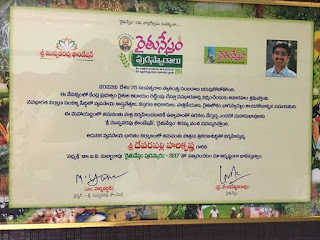It’s been more than 3 years since we started practicing
natural farming on our farm, we initially got 3 cows and started natural
farming in our 5.25 acres oil palm plot and here are my observations and I
recommend every farmer to switch to natural farming.
Input costs
On the input costs front, typical chemical farmers spend
10000 on chemical fertilizers and 4000 on farmyard manure (FYM) per acre and we
completely eliminated these and we spend around 5000 per acre on inputs to cows
and Jeevamrutham. And the remaining costs for harvesting and other regular
maintenance around 10000 per acre remain the same in both, i.e. we could save
around 40% (i.e. 10000 per acre) on input cost.
Yield
Yield improvement is phenomenal over the last 3 years since
we started natural farming 3 years back. We used to get 50+ tons in our 5.25
acres oil palm plot and it gradually increased to 80 tons per year. It’s a 46% hike
in 3 years.
Chemical Vs. Natural farming
In chemical cultivation we used give prescribed dose of
fertilizers along once in every 3 months and use weedicides every 4-5 months to
suppress weeds. We also used to give 2-3 tractor trucks of farmyard manure per
acre every alternate year. In natural farming we give around 10 liters of
Jeevamrutham per month for each palm and we also give 30-40kgs of composted
sugarcane press mud cured with Jeevamrutham to each palm every year. And for
weed control we effectively started mulching with oil palm leaves and opt for
manual weeding whenever required.
Benefits to farmer
·
30-40% reduction in input costs.
·
40-50% improvement in yield.
·
This translates to Rs 40000-50000 additional
income per acre( Oil palm bunches fetches 8000 per ton)
·
Improvement to soil fertility and water holding
capacity.
·
Reduced water consumption.
·
Improved drought and stress resistance for
crops.
Benefits to mother Earth
·
No soil pollution and soil fertility improves
year on year.
·
No water pollution because of chemical
fertilizers, pesticides and weedicides.
·
No harm or destruction to numerous soil
microbes, honey bees, insects, frogs, birds and many other species.
Other benefits
·
No chemical and pesticide residues in our food.
·
Food with improved nutritional values.
·
Governments can save on input subsides given on
chemical fertilizers.
























